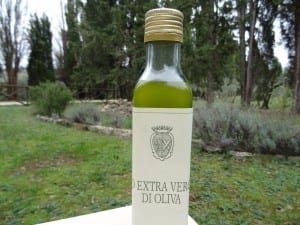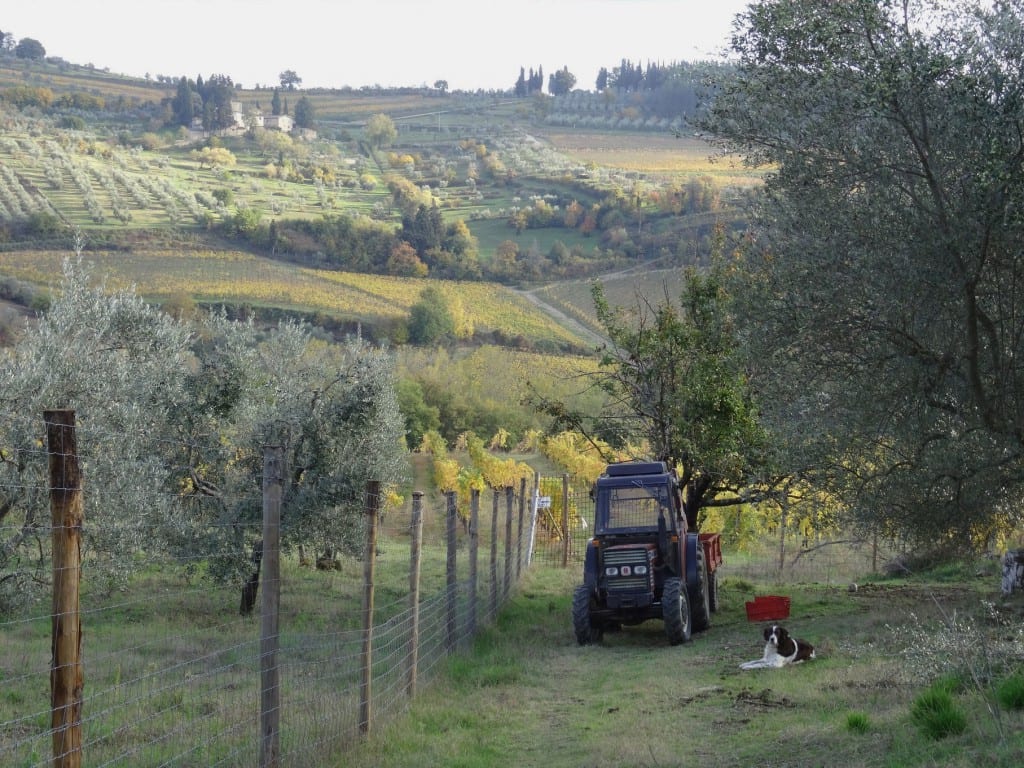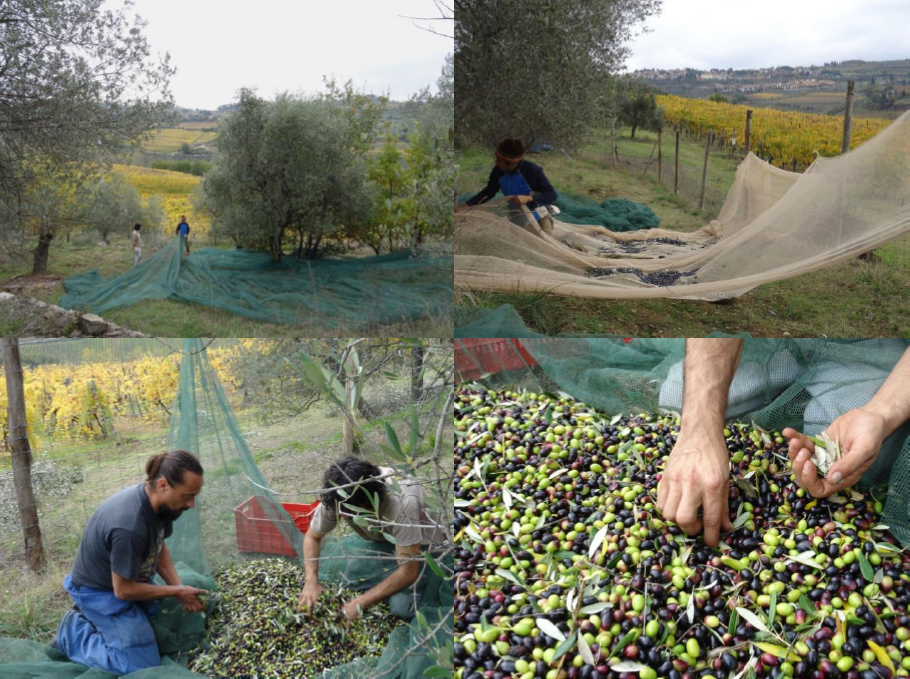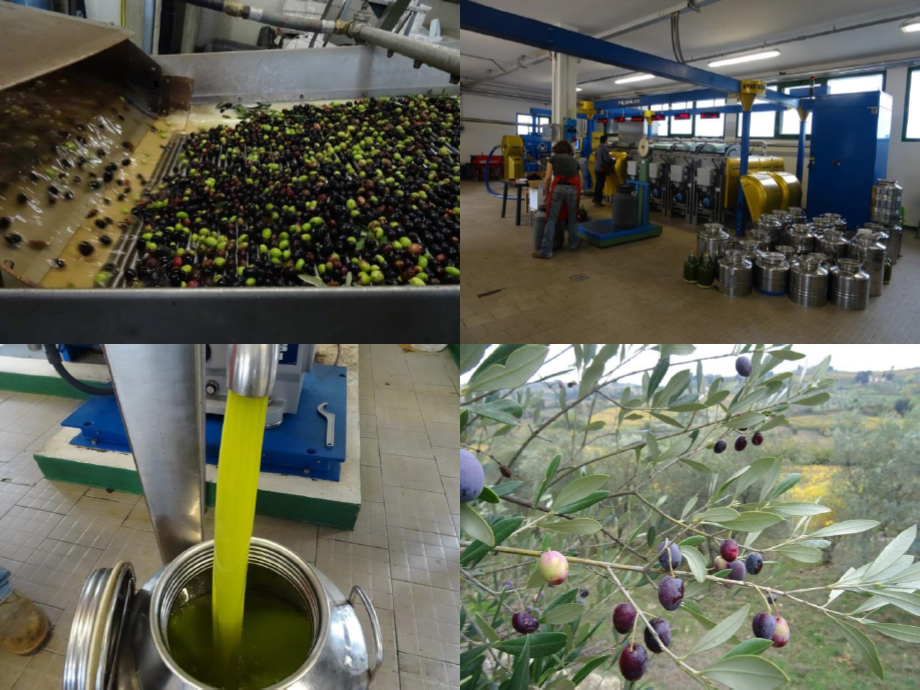Now midway into November, as the red and yellow colors of autumn beautifully blanket the hills and fields, the splendor of the autumn dining table is amplified all
at once as well. Although mushrooms like porcini or truffle, chestnuts, persimmons, and wine grapes are representative of autumn food, I would definitely like to recommend to anyone visiting Italy at this time of the year to try this unique palate – fresh olive oil.Olive oil, a staple in cuisines of Mediterranean countries, has been gaining popularity recently as a food low in cholesterol, but Italy’s first-class food-use olives are also one of the important palates of autumn. Here in Florence on the surrounding hills, the season’s first olive oils are harvested and planted from mid-October to mid-November.
 Freshly extracted olive oil
Freshly extracted olive oil Freshly picked olives
Freshly picked olivesJust like wine made from grapes, the taste of the season’s first olive oils are also impacted heavily by the production region of the olives, the manufacturer, the manufacturing method as well as the climate of that year. The newly produced oils are highly prized because the strong distinct flavor of the olive fruit, the tingling aftertaste of the pleasant pungency or bitterness, and the beautiful emerald green color are most notably apparent immediately after production. Afterwards with the passage of time, the flavor becomes milder and more uniform, the color lightens from green to a more yellowish color, and the striking impact of the freshly produced olive oil slowly weakens. It’s also around this time of the year that everyone enjoys many opportunities with friends and coworkers of comparing the tastes or showcasing the various kinds of olive oil you’ve bought from manufacturers both large and small or of homemade olive oil that you’ve received. Simple usages like fresh olive oil with salt on bread, as a dressing for salads, and a drop on soup are what bring out the best of olive oil, the manufacturers give very delicate care and attention to the entire process leading to its production. From year round management of the farm to careful picking and removal of contaminants as well as the cold-pressing and preservation method for maintaining the flavor and freshness of the olive fruit, the earnest and serious attitude the Italians have towards food can be seen.
 The vineyard and olive grove surrounded by tranquil mountains
The vineyard and olive grove surrounded by tranquil mountainsFor the purpose of reporting on this topic, I visited an olive oil manufacturer in the town of Panzano in Chianti, located in the center of the Chianti region. This region had been engaging in olive oil production since medieval times, and the manufacturer that happily accepted my request of covering the process involved in olive oil production was the BALDASSERONI noble family that has been controlling land in this region for around 300 years. They operate a farm called FATTORIA DI QUERCETO BALDASSERONI . They are currently involved in the production of wine and olive oil, and are characterized by their organic cultivation and production with a distinct, rich taste.
 Spreading out a net to make sure olive fruits are harvested without waste and removing contaminants
Spreading out a net to make sure olive fruits are harvested without waste and removing contaminantsOn that day, under the relatively cloudy skies of early November, I had the opportunity to observe all the workers among the mild olive green trees against the backdrop of the brilliantly yellow post-harvest vineyard. Although some machine equipment are used, seeing this scenery of the delicate task of picking olives was almost like peering into the real Italy that normally can’t be seen in cities.
 Inside the olive oil factory. A modern facility for the cleaning, pressing and agitating processes of the olive fruits. Freshly extracted oil has a shiny green color.
Inside the olive oil factory. A modern facility for the cleaning, pressing and agitating processes of the olive fruits. Freshly extracted oil has a shiny green color.Following the picking task is a rather strictly controlled pressing process carried out with a modern press. In the last process when I saw the transparent emerald green olive oil come gushing out, the view touched me as I recalled the olive fruits prior to the harvest. Through the observation of this food ingredient’s production process, I enjoyed another precious experience that deepened my understanding of Italy’s richness.
 Freshly extracted olive oil
Freshly extracted olive oil Freshly picked olives
Freshly picked olives The vineyard and olive grove surrounded by tranquil mountains
The vineyard and olive grove surrounded by tranquil mountains Spreading out a net to make sure olive fruits are harvested without waste and removing contaminantsOn that day, under the relatively cloudy skies of early November, I had the opportunity to observe all the workers among the mild olive green trees against the backdrop of the brilliantly yellow post-harvest vineyard. Although some machine equipment are used, seeing this scenery of the delicate task of picking olives was almost like peering into the real Italy that normally can’t be seen in cities.
Spreading out a net to make sure olive fruits are harvested without waste and removing contaminantsOn that day, under the relatively cloudy skies of early November, I had the opportunity to observe all the workers among the mild olive green trees against the backdrop of the brilliantly yellow post-harvest vineyard. Although some machine equipment are used, seeing this scenery of the delicate task of picking olives was almost like peering into the real Italy that normally can’t be seen in cities. Inside the olive oil factory. A modern facility for the cleaning, pressing and agitating processes of the olive fruits. Freshly extracted oil has a shiny green color.Following the picking task is a rather strictly controlled pressing process carried out with a modern press. In the last process when I saw the transparent emerald green olive oil come gushing out, the view touched me as I recalled the olive fruits prior to the harvest. Through the observation of this food ingredient’s production process, I enjoyed another precious experience that deepened my understanding of Italy’s richness.
Inside the olive oil factory. A modern facility for the cleaning, pressing and agitating processes of the olive fruits. Freshly extracted oil has a shiny green color.Following the picking task is a rather strictly controlled pressing process carried out with a modern press. In the last process when I saw the transparent emerald green olive oil come gushing out, the view touched me as I recalled the olive fruits prior to the harvest. Through the observation of this food ingredient’s production process, I enjoyed another precious experience that deepened my understanding of Italy’s richness.






























































